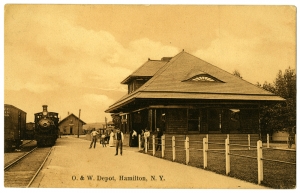Sweet, ’01, and the manager was J. Ambler Williams, ’01. The first intercollegiate game was with the University of Vermont at Burlington on January 25th which Colgate lost 6 to 8, and the first home game was with Hamilton College February 2nd which Colgate won by a score of 20 to 19. From 1902 to 1905 Walter Runge matched his football accomplishments with those of equal skill on the basketball court. By 1908 enthusiasm for basketball in the winter and spring seemed to equal that for football in the fall.
The fine cinder track facilities of Whitnall Field aroused a new interest in field sports in which Colgate began to excel. The versatile Frank Castleman was as outstanding a sprinter as a football star and set four Colgate records which stood for at least twenty years. In 1903 the team won the New York State Intercollegiate Track Association pennant for the third straight year and in 1904 Castleman and the captain, C. Roy Nasmith, ’04, earned gold and silver medals at the St. Louis World’s Fair.
Baseball seems to have declined in popularity, though good teams represented Colgate, especially in 1900 and 1901. One observer attributed the lack of interest to the competition of other springtime activities such as track, tennis, and final examinations. To these might be added poor baseball weather and Junior Prom.
To recognize excellence in sports, the Block “C”
annual award by the Athletic Advisory Council was instituted in 1900. The first recipients were members of the baseball, track and football teams with the latter being entertained at dinner at the President’s home by Dr. and Mrs. Merrill.





